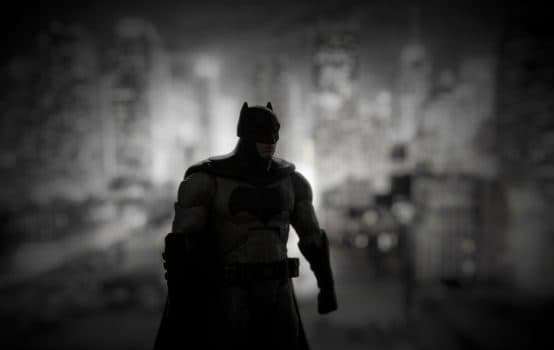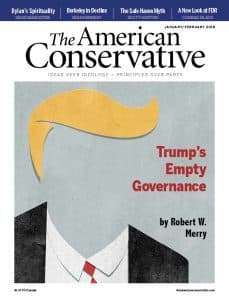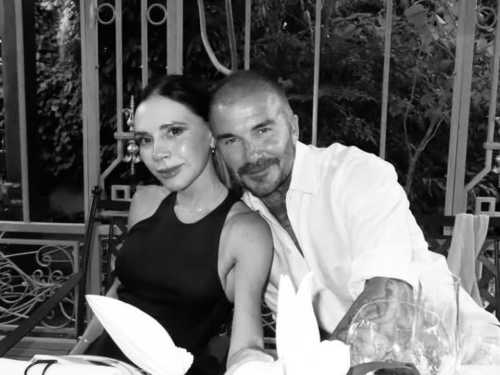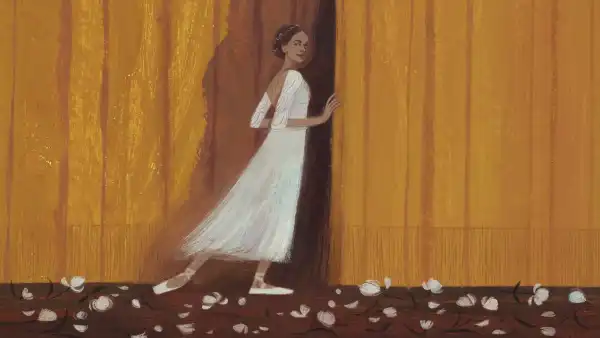
“I see a beautiful city and a brilliant people rising from this abyss. I see the lives for which I lay down my life, peaceful, useful, prosperous and happy. I see that I hold a sanctuary in their hearts, and in the hearts of their descendants, generations hence. It is a far, far better thing that I do, than I have ever done; it is a far, far better rest that I go to than I have ever known.”

This article appears in the January/February 2018 issue of TAC.
—Obituary for Bruce Wayne, taken from Dickens’s A Tale of Two Cities
In 2005, Time Warner released Batman Begins, the first high-budget film by Anglo-
American filmmaker Christopher Nolan (who later did Dunkirk, Inception, Interstellar), known at the time only to a few cinema nuts for his low-budget but intensely artful and intellectual films (Memento). The Batman franchise—from novels to comic books to movies to toys—had been a hugely profitable property for Time Warner for years. Still, most Americans viewed Batman as a really neat comic book figure. “Be yourself. Unless you can be Batman. Then, be Batman.” When the character had appeared on screens, it was as a countercultural buffoon on television in the 1960s, then two decades later as a big-screen gothic and carnival-esque weirdo in the hands of Tim Burton and his followers. Only Bruce Timm’s excellent animated Batman, which aired afternoons during the early 1990s, did the character justice, but this version, given the medium, reached only a handful of diehard Batman fans.
And so with Nolan the question emerged: could this newcomer to big film projects transfer his cinematic intensity and intellectualism to Batman, thus transforming him from pop sensation to a cultural mainstay, giving the property gravitas and the studio profit?
The answer, it turns out, was yes. Two central elements of Nolan’s filmmaking characterized his particular Batman genre. First, he brought the characters into the realm of realism. They reside in the actual world, not a fantasy world, and events and developments can all be explained rationally. Second, Nolan fashioned his central character not from the pastel pages of a comic book but rather from America’s western legend, the frontier mythos that captured the national consciousness so powerfully in multiple movies of the 1940s and TV shows of the 1950s. This western legend, or myth, was larger than any single person, event, or even culture. And there were no antiheroes in that cultural fare, focused on the daunting challenge of extending the essence of Western civilization to those forbidding and often dangerous lands of the Rocky Mountains and beyond. It took real heroes to do that.
Thus does Nolan’s Batman trilogy stand today as a remarkable cultural achievement. Indeed, his third film in the trilogy, The Dark Knight Rises, was not only the best of the three but is arguably one of the finest movies ever made, a true achievement of the cinematic arts, certainly worthy of an Alfred Hitchcock or a John Ford. It also may be the single most important defense of Western civilization ever to reach a Hollywood screen. That the severe cultural liberals of the West Coast didn’t rip it to shreds indicates they probably didn’t watch it—or perhaps didn’t understand it.
In crafting his Batman movies, Nolan pulled together his longtime core development team—his wife, Emma, and his brother, Jonathan—but he also turned to his troupe of actors from previous projects, including Christian Bale and Cillian Murphy. Nolan, though a longtime Batman fan, had never been a collector or reader of comic books, and he concluded that he needed an expert in the original comic book Batman. He wisely turned to David Goyer, an Ann Arbor native, and lifelong comic book fan and writer. Goyer not only had written for DC and Marvel (the two main comic book companies and friendly rivals) but also had written some extraordinary film scripts, such as the Gothic noir dystopia, Dark City (1998), arguably one of most imaginative science-fiction films ever made.
Partly because he was untried in this kind of filmmaking and partly because of his own artistic sensibilities, Nolan developed no initial plan for any sequels. He wanted every member of his team to see this film as a one-time opportunity, holding nothing back in its making. As he put it:
People ask if we’d always planned a trilogy. This is like being asked whether you had planned on growing up, getting married, having kids. The answer is complicated. When David and I first started cracking open Bruce’s [Bruce Wayne’s] story, we flirted with what might come after, then backed away, not wanting to look too deep into the future….I told David and Jonah to put everything they knew into each film as we made it. The entire cast and crew put all they had into the first film. Nothing held back. Nothing saved for next time.
As Nolan approached the story, he decided two critical things. The first was his insistence on realism. If something happened that could not be explained rationally, he excised even the idea of it. Everything from the Batmobile to the reaction of the police had to be utterly realistic. If the Batman headgear needed two ears, there needed to be an explanation for those two ears. If Batman jumped from building to building, there needed to be a reason why and explanation as to how. The second was his embrace of the myths of the American West. Here Nolan was tapping into something already in the Batman mythos but not explicitly understood by the larger public. Like Natty Bumppo of James Fenimore Cooper’s “Leatherstocking Tales” and Mark Twain’s Huck Finn, Bruce Wayne/Batman stands as a crucial American symbol. If Bumppo and Finn personify the American frontier of the 19th century, so Wayne/Batman is the great mythological figure of 20th and 21st century urban America. Named after the Revolutionary War general, Mad Anthony Wayne, and coming from one of the wealthiest of American families (builders and defenders of Gotham City, a Platonic shadow of New York, populated by 30 million people), Bruce Wayne considers it his aristocratic duty to protect the poor and oppressed from the wealthy and corrupt. He is an Arthurian but also deeply American figure.
In the Batman stories as developed in the comics over the last three decades, it has come to light that the Waynes have been keepers of the Holy Grail in the present day, descendents of Arthur from 2000 years ago. As with Arthur, Wayne surrounds his Batman persona with a number of knights (the Gotham Knights) who serve under such codenames as Nightwing, Robin, Oracle, and others. While, to our modern eyes, they seem much like a Marine platoon, they more properly resemble the Catholic military orders of the High Middle Ages. As with Arthur, Wayne must enter the Chapel Perilous, time and again, to keep the darkness of the Waste Land at bay.
Brilliantly, Nolan wrapped the eventual Dark Knight Trilogy into the significance of myth, and the significance of myth into the story. When attempting to explain to Alfred, his father figure, butler, and accomplice, what he hoped to do when returning to Gotham City, Wayne says: “People need dramatic examples to shake them out of apathy and I can’t do that as Bruce Wayne. As a man I’m flesh and blood. I can be ignored. I can be destroyed. But as a symbol, as a symbol I can be incorruptible, I can be everlasting.”
♦♦♦
Several themes inform each movie. The first movie deals with justice and fear; the second with free will and anarchy; the third with hope and reformation.
In Nolan’s typical but eccentric way, the first movie jumps repeatedly in time, creating a whole out of non-linear storytelling. The essential tale is familiar, at least to Americans born after 1939, but Nolan adds his own tastes and vision.
The son of the wealthiest couple in the greatest city of the Western world, Gotham, Bruce Wayne, as a young boy, stands with his parents in “Crime Alley,” having left the opera. A killer shoots both parents and takes their money and jewels. Left an orphan, Bruce is raised by the family butler, Alfred Pennyworth. After dropping out of Princeton and ineffectively confronting the man he believes ordered the hit on his parents, Wayne departs Gotham City, traveling throughout the world for years, learning what it means to fight, to suffer, and to survive. The purpose, as he sees it, is to hone all his skills—physical as well as intellectual—and return to Gotham to protect the innocent.
In Batman Begins, Wayne finds himself in a high Tibetan temple belonging to an evil and inverted type of Knights Templar, the “League of Shadows,” an organization that demands the end of corruption of public officials. It calls them to account by destroying any city that has become unrepentantly corrupt. They claim responsibility for having destroyed Rome, Constantinople, and London, across the centuries. Now they say they will take out Gotham. The leader is a man named Ra’s al Ghul, an Arabic title meaning, “Head of the Demon.” The League portrays itself as superior to all political organizations in promoting what it sees as justice, a harmony derived from a very Nietzschean desire for the “will to act.” The League of Shadows, Ra’s al Ghul explains, has been a check against human corruption for thousands of years. “We sacked Rome. Loaded trade ships with plague rats. Burned London to the ground. Every time a civilization reaches the pinnacle of its decadence, we return to restore the balance.”
Though trained by the League of Shadows to be the heir to Ra’s al Ghul, Wayne rejects its brutal philosophy, destroys its temple, and returns to Gotham, presuming incorrectly that he has destroyed the League.
Back in Gotham, he assumes the primal symbol of his own fears, a Bat, hoping to employ terror against evil. As a Batman, he stands as a living gargoyle, adorning the cathedral of Western civilization while driving away rival evils. In his fight, he relies on four persons to sustain him: Alfred, to serve as Watson to his Holmes; Police Lieutenant James Gordon, the only honest cop in Gotham; Lucius Fox, a master engineer and entrepreneur; and Rachel Dawes, the one true love of his life, now an assistant district attorney. Rachel particularly complicates Wayne’s life, as she is unsure of his sanity and his intentions, especially in his assumption of the Bat persona.
The movie—operatic in a Wagnerian way from opening to final scene—concludes with Wayne barely defeating the revived Ra’s al Ghul and his League of Shadows. In the war against the League, Wayne Manor is destroyed, Rachel reveals that she cannot love a man who fights crime as a Bat, and a poison is loosed upon an area of Gotham known as “The Narrows,” a decayed part of the city that houses the poor and the insane. The consequences of this poison remain unknown as the movie ends, but Lieutenant Gordon, now fully in alliance with Batman, shows him the “calling card” of a new masked criminal, a grimy playing card of a joker.
The second movie, The Dark Knight (2008), begins with the Joker and his henchmen stealing from a mob bank. The heist, filmed as a tribute to such crime neo-noir classics as The French Connection (1971) and Heat (1995), goes off as planned, introducing the audience to the face of diabolic anarchy and insanity, the stunning Joker (played by Heath Ledger, who died in a drug overdose after filming).
Unlike the first movie, filmed almost entirely in shadow, with vertical lines and a Gothic noir aesthetic, The Dark Knight presents a much shinier and sunnier Gotham, its architectural lines straight, sleek, clean, and horizontal. This story, atypically for Nolan, is linear, driving relentlessly from the opening heist to the final tragic moments.
The story centers on the Joker’s attempt to destroy Gotham from within, through anarchy. As he puts it:
I’m a dog chasing cars … I wouldn’t know what to do with one if I caught it. I just do things. I’m just the wrench in the gears. I hate plans. Yours, theirs, everyone’s. Maroni has plans. Gordon has plans. Schemers trying to control their little worlds. I’m not a schemer, I show the schemers how pathetic their attempts to control things really are. So when I say that you and your girlfriend was nothing personal, you know I’m telling the truth.
He may denigrate plans, but the Joker is a master chessman, planning and scheming, always three or four moves ahead of his opponents. According to all law enforcement databases, the Joker should not exist—no fingerprints on record, clearly trained in some form of special ops, outfitted entirely in custom clothes.
Though The Dark Knight deals with anarchy and plans, the movie also probes the notions of free will and duality. If we choose A, are we doomed to follow B? If we follow B, have we destroyed all future options? The question manifests itself most particularly in the personal story of Harvey Dent, a young and courageous district attorney, ready to become the face of decency in Gotham, a White Knight, replacing Batman’s Dark Knight.
To prove that no real goodness resides in the world, the Joker plays upon Dent’s weaknesses, killing his girlfriend (Rachel Dawes, also Wayne’s one love) and driving him to madness and evil deeds. In the final scene, with Gotham not knowing that Dent had succumbed to the Joker’s dark spirit, Dent takes Lieutenant Gordon’s family hostage. In the fight to protect Gordon’s children, Batman plunges over a building ledge in a fight with Dent. Dent is killed. Batman tells Gordon that he will take the blame, though he has done nothing wrong. The movie ends with Batman having saved hundreds of lives, defeating the Joker and Dent, but now becoming a hunted man, vilified as a murderer. “You’ll hunt me. You’ll condemn me. You’ll set the dogs on me.” But Gordon explains to his son that Batman is “a silent guardian, a watchful protector, a dark knight.”
Hoping to shed the vigilante mantle of the Batman, Wayne and Police Commissioner Gordon decide to place all of their hopes on District Attorney Harvey Dent, the “White Knight” as opposed to Wayne’s “Dark Knight.” Harvey, though, hides an unrestrained abusive side, one that revels in torture. Knowing this, the Joker manipulates events in the movie—always three or four moves ahead of the good guys as if in a masterful game of chess—to force Dent to reveal this horrific side. Rather than allow the symbol to die, Wayne and Gordon decide to hide it, allowing Dent to die a martyr as the White Knight, placing, then, the abuse and killings committed by Dent on the Batman.
After The Dark Knight, Nolan insisted he had no intention of making a third movie. The death of his friend Heath Ledger rattled him, inhibiting any return to the world of Batman. But Batman wouldn’t leave him alone, he later explained, and he had to produce the third movie to find out how the story unfolds.
Nolan’s third Batman film was inspired by Charles Dickens’s A Tale of Two Cities, though much of the dialogue might have been written by the Anglo-Irish statesman Edmund Burke, considered by many the father of modern conservatism. The movie is in essence a retelling of the events of the French Revolution in Paris. In place of Robespierre is a mercenary, chemically-enhanced villain from either Eastern Europe or the Mideast, known only as Bane. This character is the creation of noted writer Chuck Dixon, a man both admired and reviled in the comic book world for his conservatism. Bane, working with several of Wayne’s competitors in business, has spent six months rebuilding the infrastructure of Gotham City, secretly lacing all of the concrete in streets, bridges, tunnels, and sewers with explosives. He considers himself the fulfillment of the infamous League of Shadows.
Coming out of retirement at 43, Batman investigates. But, when he encounters Bane in the sewers, the evildoer breaks his back. Bane takes the injured Wayne to a prison somewhere in the Middle East (filmed in an ancient city on the Pakistan-Indian border) and leaves him there to die. Languishing in this hell hole with his broken back, Wayne is reduced to watching TV, specifically, a single Gotham City channel. Bane wants Wayne to see the fall of Gotham as it implodes and collapses in on itself from the weight of its own corruption. In lines that could have been lifted straight out of Volume I of Alexander Solzhenitsyn’s The Gulag Archipelago, Bane explains to Wayne that while he is happy to have broken Wayne’s body, the prison is meant to destroy his soul.
Returning to Gotham, Bane detonates his explosives, destroying the city’s infrastructure as well as its access to and from the main island—the equivalent of Manhattan. In taking over the city, he warns the United States not to intervene or he will unleash a nuclear weapon with a six-mile blast radius, killing all on the island. By separating Gotham from the United States, Bane has created his own city-state. In the new, conquered city of Gotham, Bane frees all prisoners of Blackgate Prison (the Bastille) and declares the city to be under control of “the people.” The people, Bane says truthfully, have been deceived by the leadership of Gotham. Harvey Dent was not a White Knight but an insane, murderous criminal. Thus all of Gotham’s successes over the previous eight years, since Dent’s death, have been lies. Bane declares:
We take Gotham from the corrupt. The rich. The oppressors of generations who’ve kept you down with the myth of opportunity. And, we give it to you, the people. Gotham is yours. None shall interfere. Do as you please. . . . For an army will be raised. The powerful will be ripped from their decadent nests, and cast into the cold world the rest of us have known and endured. Courts will be convened. The spoils will be enjoyed. Blood will be shed.
In Soviet style, the criminal, the insane, and the poor ravage the homes, property, and persons of the wealthy, inverting the entire socio-economic structure of Gotham. The people—under the judgeship of Dr. Jonathan Crane, the “Scarecrow” and creator of the poisons in the first film—establish courts to sentence the wealthy for having preyed upon the poor. All such trials end in the execution of the guilty. This level of anti-communist passion has not been seen from Hollywood since Roland Joffé’s revealing if horrifying 1984 look into Cambodia under the Khmer Rouge, The Killing Fields.
Meanwhile, in his Middle Eastern prison, Bruce Wayne heals and regains his strength, spiritually as well as physically, climbing out of the pit (Plato’s Cave), liberating himself and his fellow prisoners. The fact that only one person had ever escaped from this prison heartens Wayne, for he calculates that if one person had escaped he could too.
Returning to Gotham City, Wayne as Batman takes control of the remaining police under Gordon’s command, raising a counter-revolutionary army. Leading hundreds of police into battle, he and his greatest ally, a somewhat reformed jewel thief named Selina Kyle, battle Bane and his revolutionaries. In hand-to-hand combat outside the Gotham City stock exchange, Kyle and Batman barely defeat Bane. Still, there remains the nuclear bomb. Taking his Bat—a hover aircraft based on the Harrier and the helicopter—Batman flies the bomb out of the city, over the Atlantic, and lets it detonate safely. Everyone assumes, however, that Batman sacrificed himself in saving Gotham.
♦♦♦
At the funeral—attended only by four loved ones—a shell-shocked Gordon, who has only now come to realize the true identity of Batman, reads from The Tale of Two Cities. Looking at the grave of Wayne, next to that of Wayne’s mother and father, Alfred breaks down, believing that his entire life has been a failure. He had wanted to serve the Wayne family but had overseen its death.
The movie ends with Wayne Manor becoming a home for orphaned boys, St. Swithin’s, led by a Catholic priest. Also Lucius Fox begins to think that Wayne might have survived the flight over the Atlantic while Gordon refurbishes the long disused Bat signal and Alfred sits in an outside French café, seeing Bruce and Selina sitting together, in love, at a neighboring table.
In Nolan’s expert hands, Batman becomes what he always meant to be, an American Odysseus, an American Aeneas, an American Arthur, an American Beowulf, and an American Thomas More. Indeed, it would be hard to find another figure in popular and literary culture that more embodies the traditional heroism of the West more than in the figure of Bruce Wayne. He most closely resembles Aeneas, carrying on the culture of charity and sacrifice into the darkest and most savage parts of his world. Like St. Michael, he guards the weak, the poor, and the innocent. Like Socrates, he will die for Athens (Gotham) as it should be rather than as it is. Like Beowulf, he asks nothing for himself, merely the opportunity to wage the never-ending war against evil.
And in the third film, Western civilization survives, but only barely and only with incredible sacrifice at every level. “I see that I hold a sanctuary in their hearts, and in the hearts of their descendants, generations hence,” Dickens had written.
While some might still see merely a children’s comic book superhero made glittery with a Hollywood budget in the Dark Knight Trilogy, it would be impossible not to recognize Nolan’s genius in these films. Unlike, say, Peter Jackson, who dumbed down The Lord of the Rings, Christopher Nolan leavened Batman. Jackson diminished Tolkien, while Nolan enlarged Batman.
Since his creation in 1939 by two young Jewish artists in New York, Batman has served as a critical cultural marker for American and Western civilization. If we treat him like a clown, as did the 1960s TV series, we do not know who he is—or who we are. If we treat him like a Gothic carnival freak, as did Tim Burton, same thing. If we treat him as the great American hero and symbol of an urban age, as did Nolan, we have a chance at survival.
Bradley J. Birzer is the president of the American Ideas Institute, which publishes TAC. He holds the Russell Amos Kirk Chair in History at Hillsdale College and is the author, most recently, of Russell Kirk: American Conservative.
Sourse: theamericanconservative.com






